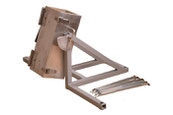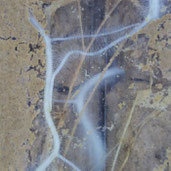Corer For Minirhizotron tubeS

A tight and gap-free fit of the Minirhizotron Observation Tubes to the surrounding soil (as in the example image) is essential for correct observation of the 'hidden half', preventing artificial root growth in gaps and along the tube and keeping the Minirhizotron Camera in focus. Hand augers are generally not suitable for installing Minirhizotron tubes due to the rough surface created during drilling. Instead, the use of a manual corer with a sharp cutting edge and a slightly smaller diameter than the MR tubes is recommended for best results. An corer alignment frame is available for the standardized installation of MR tubes at an angle (e.g. 45° or 60°).
Coring Systems for Minirhizotron Tube Installation
Corer for MR Tubes. Vienna Scientific and Bartz Technology Corporation supply soil corer kits that are suitable for installing root observation tubes to a depth of approximately 1 m. As a rule of thumb, the outer diameter of the soil corer should be 2-3 mm smaller than the outer diameter of the MR tubes used, but this will depend on the physical properties of the soil. In soils that tend to shrink on drying, i.e. with a high clay content, a greater difference between corer and tube size (i.e. a relatively smaller corer) may provide a tighter fit in dry soil conditions.
Bartz offers corers that fit the classic BARTZ MR tube size (2"). Vienna Scientific can produce manual coring systems for gapless insertion of Minirhizotron tubes in a variety of diameters and lengths. See below and our Soil Corer website for images of the VSI corer systems.
If Minirhizotron tubes are to be installed at a specific angle (e.g. 45°), VSI offers alignment frames (see below).
Bartz Technology Corporation supplies the 2 inch coring systems for root observation tubes for researchers who have the need to install minirhizotron tubes in non-metric dimensions.
Alignment Frame to Install Minirhizotron Tubes at Defined Angles

Alignment Frame for MR Corer. If the Minirhizotron tubes are installed at a specific angle (e.g. 45°), VSI offers an aligning frame to position the corer correctly & standardized. A sturdy metal frame with skid inserts surrounds the corer and can be anchored to the floor with pegs. Fits corers up to 80 mm outer diameter. For shallow MR tube installations, the corers should be ~30 cm longer than the target depth; for deeper MR tube installations, the alignment frame can be removed once the corer is stable in the ground. Angle is adjustable 0-90° (with indicator).
A short guide to minirhizotron tube installation

The way minirhizotron tubes are installed greatly affects the accuracy of root observations. The primary objective is to establish effective contact between the surrounding soil and the entire length of the MR tubes. The picture illustrates the effect of gaps at the MR tube-soil interface. Failure to achieve proper tube installation can result in excessive root growth in the spaces between the soil and the tube surface.
- Avoiding such gaps requires the precise creation of straight holes of appropriate diameter. However, in stony soils and organic topsoil layers, holes can be very difficult to drill and can be very irregular in shape, resulting in poor contact between the Minirhizotron tubes and the substrate. Continue reading
-
Avoiding such gaps requires the precise creation of straight holes of appropriate diameter. However, in stony soils and organic topsoil layers, holes can be very difficult to drill and can be very irregular in shape, resulting in poor contact between the Minirhizotron tubes and the substrate. In both cases, holes larger than the tube diameter can be drilled and the mineral soil can be backfilled with slurry after the tube is installed. However, this is not generally recommended as the added slurry may not retain the properties of the "grown" soil, even in the plow layer. In addition, the backfill may smear the tubes, resulting in lower quality images. For organic layers, backfilling with screened material may be an option. If possible, we recommend selecting a soil corer or slightly smaller diameter than the MR tubes to ensure a better fit in all but highly shrinking soils (e.g. high clay content). Since soils vary widely, researchers must investigate the best installation method for their environment. In addition to the coring itself, a decision should be made on the orientation of the pipe - 90° and 45° seem to be the most common installation angles. While 90° (vertical) tubes are more susceptible to preferential water infiltration along the tube surface, especially if not installed "gapless," angled placement at 45° creates inherent difficulties in terms of accurate depth imaging, and the acrylic tubes could cause changes in soil moisture content - with a "rain shadow" effect below the tubes and slightly higher moisture content on top of the tubes. As a result, many researchers using angled or horizontally installed tubes image only both lateral sides of the MR tubes.
Please contact us if you would like to discuss any other aspect of MR tube installation practice.
Soil Corers are available in different diameters and length to collect e.g. Root Biomass Depth Profiles, e.g. to calibrate Minirhizotron root length densities.
To measure soil moisture, temperature, and EC along the MR Tube root / soil profile, consider using manual or continuous Sentek soil moisture sensors. Dedicated auger are available for the gapless installation.








